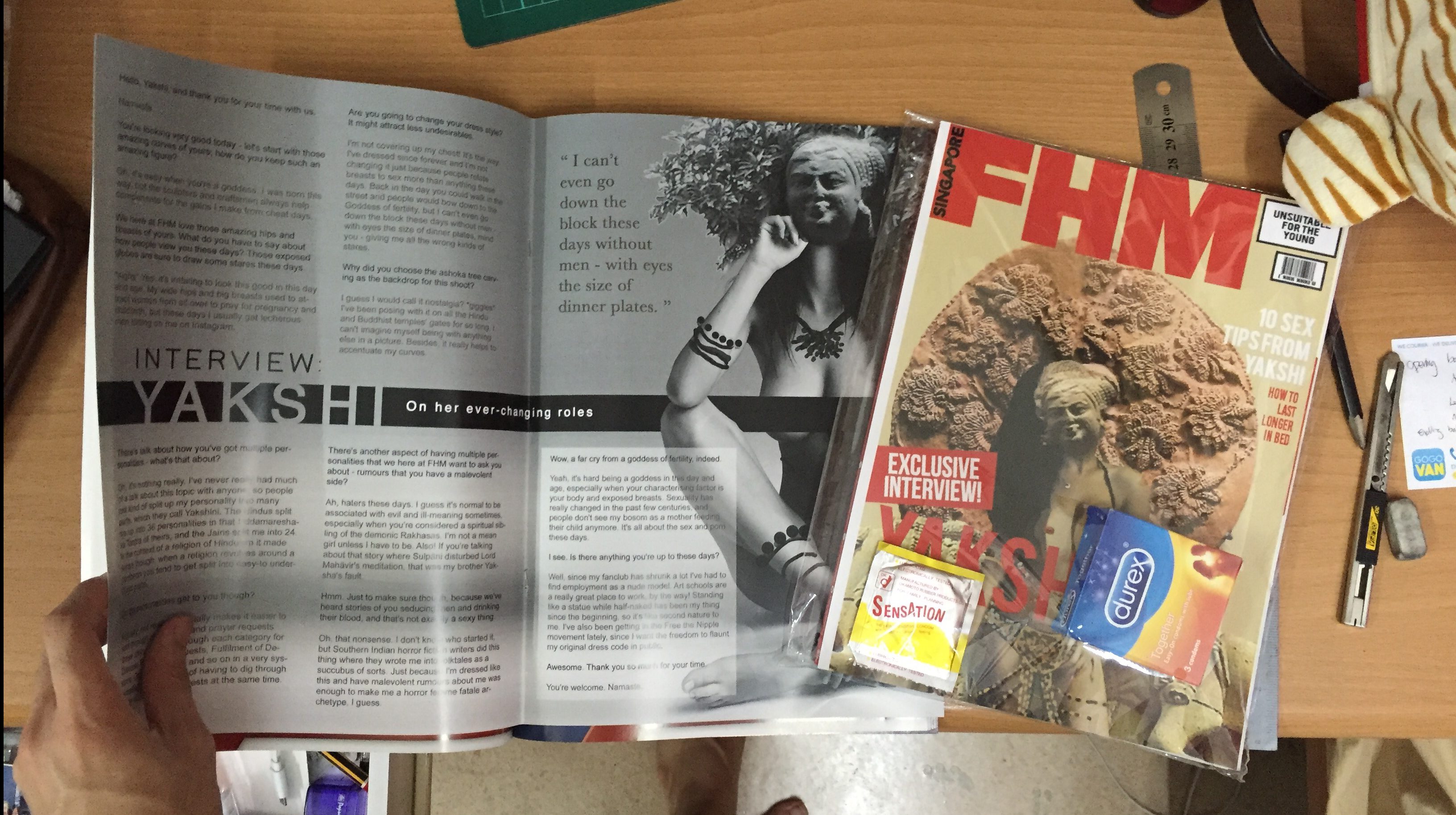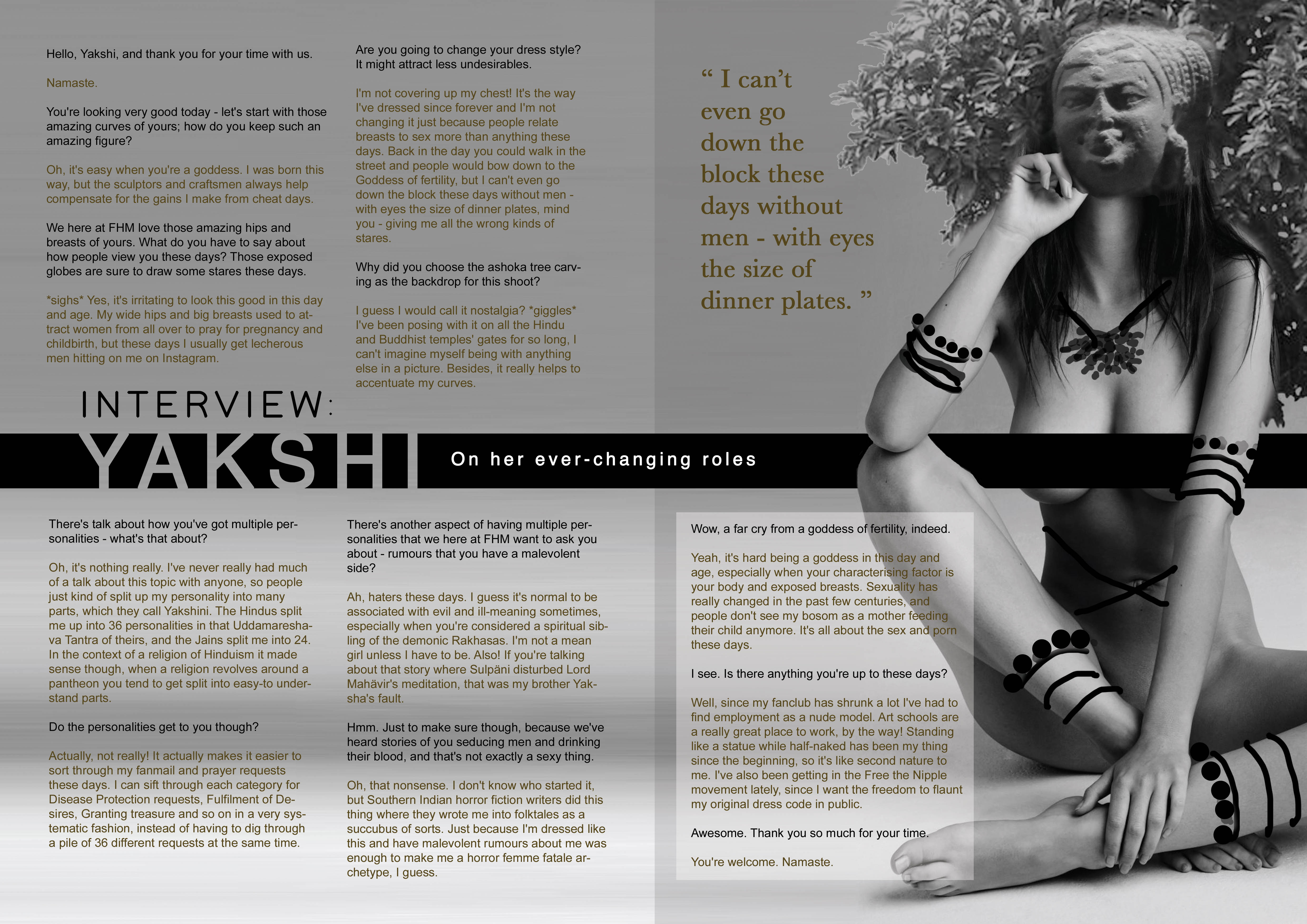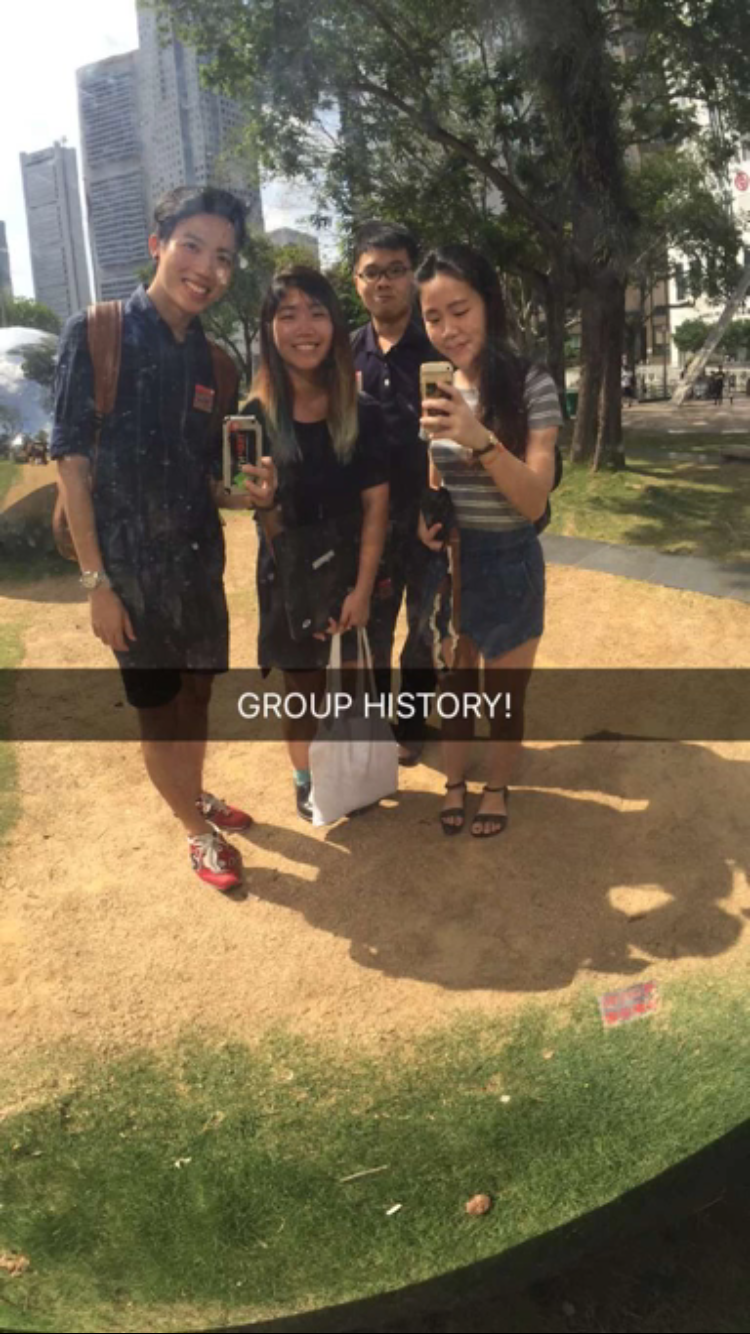Hi everyone! Thanks for a wonderful trip to history this semester! I definitely enjoyed myself more this semester. Shh, don’t tell Michael Walsh this. 😛
Below will be the following contents.
- Prototype images
- Artist Statement
- Bibliography
- Presentation Slides
- Reflection
Our Prototype Images
Questions pointed out:
- Why cover Naomi Neo’s face, and why was there two covers?
To show the irony in how we perceive the body differently when the ‘identity’ of the person changes.
- How to identify Naomi Neo, and how to identify Yakshi?
- Naomi : Tattoos and provocative dressing.
- Yakshi: A pairing of bosom, jewelleries and a flowering mango tree.
The article as followed:
An Exclusive Interview with Yakshi: On her ever-changing roles
Join us on this first-ever opportunity with the goddess herself, to talk about how society’s views of one of the hottest goddesses on the block have evolved with time – is she still the goddess of fertility, or does she mean something else now? Do people see her curves in a different light? Find out here.
Hello, Yakshi, and thank you for your time with us.
Namaste.
You’re looking very good today – let’s start with those amazing curves of yours; how do you keep such an amazing figure?
Oh, it’s easy when you’re a goddess. I was born this way, but the sculptors and craftsmen always help compensate for the gains I make from cheat days.
We here at FHM love those amazing hips and breasts of yours. What do you have to say about how people view you these days? Those exposed globes are sure to draw some stares these days.
*sighs* Yes, it’s irritating to look this good in this day and age. My wide hips and big breasts used to attract women from all over to pray for pregnancy and childbirth, but these days I usually get lecherous men hitting on me on Instagram.
Are you going to change your dress style? It might attract less undesirables.
I’m not covering up my chest! It’s the way I’ve dressed since forever and I’m not changing it just because people relate breasts to sex more than anything these days. Back in the day you could walk in the street and people would bow down to the Goddess of fertility, but I can’t even go down the block these days without men – with eyes the size of dinner plates, mind you – giving me all the wrong kinds of stares.
Why did you choose the Ashoka tree carving as the backdrop for this shoot?
I guess I would call it nostalgia? *giggles* I’ve been posing with it on all the Hindu and Buddhist temples’ gates for so long, I can’t imagine myself being with anything else in a picture. Besides, it really helps to accentuate my curves.
There’s talk about how you’ve got multiple personalities – what’s that about?
Oh, it’s nothing really. I’ve never really had much of a talk about this topic with anyone, so people just kind of split up my personality into many parts, which they call Yakshini. The Hindus split me up into 36 personalities in that Uddamareshava Tantra of theirs, and the Jains split me into 24. In the context of a religion of Hinduism it made sense though, when a religion revolves around a pantheon you tend to get split into easy-to understand parts.
Do the personalities get to you though?
Actually, not really! It actually makes it easier to sort through my fan mail and prayer requests these days. I can sift through each category for Disease Protection requests, Fulfilment of Desires, Granting treasure and so on in a very systematic fashion, instead of having to dig through a pile of 36 different requests at the same time.
There’s another aspect of having multiple personalities that we here at FHM want to ask you about – rumours that you have a malevolent side?
Ah, haters these days. I guess it’s normal to be associated with evil and ill-meaning sometimes, especially when you’re considered a spiritual sibling of the demonic Rakhasas. I’m not a mean girl unless I have to be. Also! If you’re talking about that story where Sulpäni disturbed Lord Mahävir’s meditation, that was my brother Yaksha’s fault.
Hmm. Just to make sure though, because we’ve heard stories of you seducing men and drinking their blood, and that’s not exactly a sexy thing.
Oh, that nonsense. I don’t know who started it, but Southern Indian horror fiction writers did this thing where they wrote me into folktales as a succubus of sorts. Just because I’m dressed like this and have malevolent rumours about me was enough to make me a horror femme fatale archetype, I guess.
The story I know is how I was a murdered courtesan that reincarnated as a vengeful Yakshi that seduced men and killed them afterwards. It’s all horror fiction from the local folklore, though.
Wow, a far cry from a goddess of fertility, indeed.
Yeah, it’s hard being a goddess in this day and age, especially when your characterising factor is your body and exposed breasts. Sexuality has really changed in the past few centuries, and people don’t see my bosom as a mother feeding their child anymore. It’s all about the sex and porn these days.
I see. Is there anything you’re up to these days?
Well, since my fan club has shrunk a lot I’ve had to find employment as a nude model. Art schools are a really great place to work, by the way! Standing like a statue while half-naked has been my thing since the beginning, so it’s like second nature to me. I’ve also been getting in the Free the Nipple movement lately, since I want the freedom to flaunt my original dress code in public.
Awesome. Thank you so much for your time.
You’re welcome. Namaste.
Artist Statement
The image shown is a modern interpretation of the Indian Buddhist Goddess, Yakshi. Traditionally associated with the idea of fertility and nature in ancient India, she was identified through her large, round breasts, small waist and large thighs and hips. These days, the voluptuous body that Yakshi possesses may be interpreted in a totally different way. In the modern world, sexual objectification of women have become much more commonplace, and a voluptuous body such as hers may be seen as a tool of pleasure in the eyes of men. It is no longer associated with the idea of being fertile or baby conceiving, but instead as means of sexual gratification. As such, we decided to remove Yakshi from her traditional context to show this shift in perspective towards the well-endowed body. To effectively bring across the point, we placed her into a modern piece of media that portrayed women in a more provocative manner that man would find sexually attractive.
The ambiguity created in the poster is also intentional, and meant to make viewers question the state of modern female sexuality in media; is the woman’s sexuality being subverted as part of a man-made construct, in the same way religion is sometimes criticized as a man-made construct? Or is the Yakshi/model exerting power with her sexuality, in the same way a goddess attracts worshippers? Just as how we have no idea if the models in FHM covers are happily and willingly doing their job, and as we have no idea if Yakshi is an influence or a result of influence, the state of female sexuality in the modern day is in a state of undefined flux.
Known for featuring the ‘hottest’ women on the planet, FHM was our choice of medium on which we would appropriate Yakshi. To localise it, we designed a Singaporean FHM cover featuring Yakshi in the form of Naomi Neo, a popular blogger known for her voluptuous body and outspoken attitude about sexuality. As such, we have created an artwork that appropriates Yakshi as a social statement and reflection on how much the meaning of a woman’s body have changed over the years.
Bibliography
- Manipulating Cultural Idioms.Sirhandi, Marcella C.. 1999. “Manipulating Cultural Idioms”. Art Journal 58 (3). [Taylor & Francis, Ltd., College Art Association]: 40–47. doi:10.2307/777859. http://www.jstor.org.ezlibproxy1.ntu.edu.sg/stable/pdf/777859.pdf
Represented in sculpture since approximately 200 B.C.E., the yakshi has always been conceived as a voluptuous creature with large globular breasts, small waist, and exaggerated hips and thighs. Bhattacharya’s female fatale, entwined by the vine that signifies her tie to nature, has tubular arms that echo the essence of the creeper. Her partner, emerging from the center of the flower, is literally the spirit of the plant-a common definition for yaksha/yakshi
- Unclothed sensual, feminine figure as one of the most canonical motifs of Indian art.“ART HISTORY AND THE NUDE: ON ART, OBSCENITY, AND SEXUALITY IN CONTEMPORARY INDIA”. 2004. “ART HISTORY AND THE NUDE: ON ART, OBSCENITY, AND SEXUALITY IN CONTEMPORARY INDIA”. In Monuments, Objects, Histories: Institutions of Art in Colonial and Post-colonial India, 237–67. Columbia University Press. http://www.jstor.org.ezlibproxy1.ntu.edu.sg/stable/10.7312/guha12998.13.
Over different periods and genres, the voluptuous feminine body in sculpture came to be endowed with a variety of meanings. The figures came to be read as symbols of growth, bounty, and fertility, as the embodiment of a divine maternal spirit, or as classical literary ideals. In the process, the sexual form moved from its initial primeval association with nature and fertility rites to its later, more complex divine and aesthetic connotations.
- Interacting Like a Body: Objectification Can Lead Women to Narrow Their Presence in Social Interactions. Saguy, Tamar, Diane M. Quinn, John F. Dovidio, and Felicia Pratto. 2010. “Interacting Like a Body: Objectification Can Lead Women to Narrow Their Presence in Social Interactions”. Psychological Science 21 (2). [Association for Psychological Science, Sage Publications, Inc.]: 178–82. http://www.jstor.org.ezlibproxy1.ntu.edu.sg/stable/41062184.
Sexual objectification occurs when a person is viewed as a mere body that exists for the pleasure and use of others (Bartky, 1990). This treatment targets women more often than men. For these reasons, women are theorized to willingly participate in their own objectification and become preoccupied with appearing as “good objects” (Fredrickson & Roberts, 1997).Drawing on these ideas, we predicted that when objectified, women would try not only to appear as good objects, but also to behave like ones.
- Contemporary Indian Art: A Question of Method. Sinha, Ajay J.. 1999. “Contemporary Indian Art: A Question of Method”. Art Journal 58 (3). [Taylor & Francis, Ltd., College Art Association]: 31–39. doi:10.2307/777858. http://www.jstor.org.ezlibproxy1.ntu.edu.sg/stable/pdf/777858.pdf
Taking reference from contemporary Indian art, much of which centres around adapting Indian cultural symbolism, was an important stepping stone in our process. Ravinder Reddy and other contemporary Indian artists’ works subvert or transform the meaning of traditional religious figures such as Kali and Yakshi into modern-day works into modern-day contexts, which served as an inspiration for our project.
Presentation Slides
Here is the ppt slides in pdf format for viewing again.
Reflections
Firstly, I would like to address that this last assignment was really enjoyable and educational as adding a modern twist towards history really heightened my interest in it and made me want to find out more myself.
For our project, we chose a controversial topic that might be uncomfortable to some as it includes nudity or part of it. Though we struggle with ourselves with the question of going ahead with the idea or choosing something more family friendly, we decided that if our creation provokes something in someone, be it good or bad, we have already succeeded in something. What is art if it doesn’t make you think or make you feel? That is what we are going with and are proud of our end results.
Adding on to the previous point, to make someone connect to something, the most basic is to create a connection, a relatable point of view. Taken in the consideration that the piece is based in Singapore, we decided to have a twist with the iconic FHM magazine and well-known blogger Neomi Neo, both merging with the piece to create something that people would understand better with their contextual knowledge.
We also didn’t want to neglect only the visuals and added a witty spread as seen from our final presentation to add interest and have a better execution as a whole project.
Lastly, working as a team, we had to agree that different people have different set of skillsets. To understand what the individual would excel with, and assigning it to them would hugely benefit the group, like how Jo Inng is good in her writing and Evangeline her digital painting. Overall I feel that our team was quite a well rounded one and am glad to be paired with them.
Thank you!
#BOSOMBUDDIES




